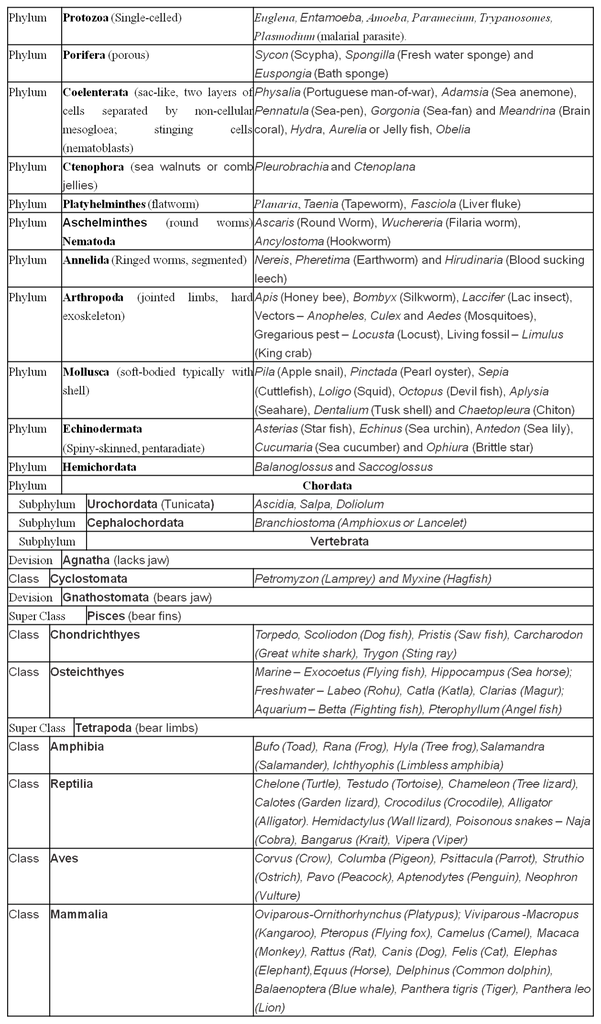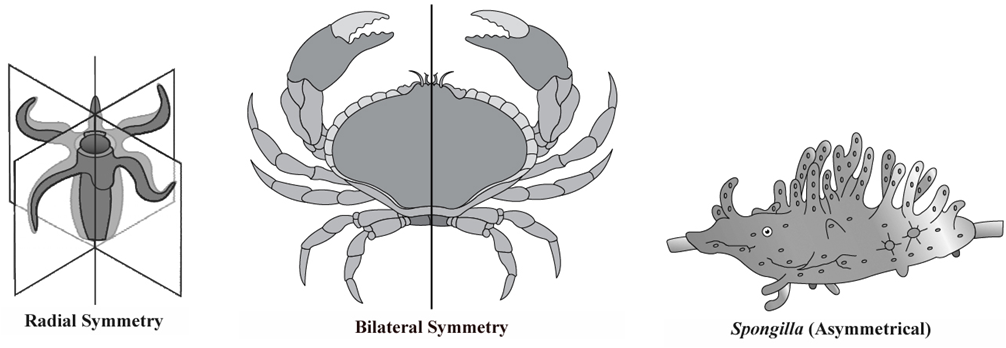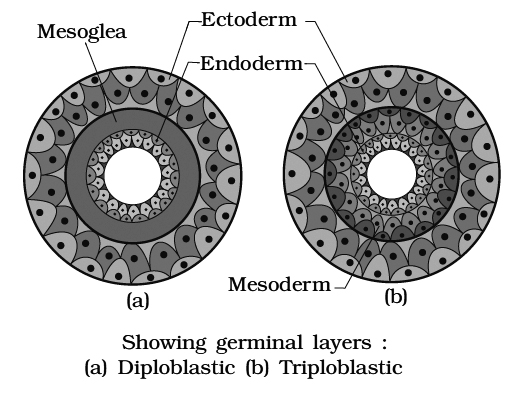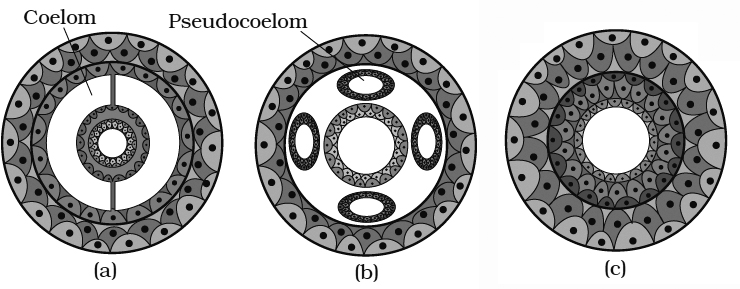- Books Name
- ACME SMART COACHING Biology Book
- Publication
- ACME SMART PUBLICATION
- Course
- CBSE Class 11
- Subject
- Biology
Animal Kingdom covers about 35 phyla, of which 11 are considered to be major phyla. In major phyla, 10 are from Non-chordates and 1 from the chordates.
HABITAT
The place on the earth, where an animal finds optimum conditions for food and shelter is called its habitat. Habitat can be defined as the physical and geometrical space where an organism lives.
The habitat may be water, soil or earth’s surface. On the basis of their habitat, animals can be of following types :
1. Terrestrial habitat :
Animals which live on land or dry earth’s surface, are said to have terrestrial habitats.
Terrestrial animals are adapted for following types of habitat modes :
a. Aerial or flying : These animals possess wings and therefore can fly. e.g., Birds, bats.
b. Arboreal : These animals mainly live on trees. e.g., Bat, Monkey.
c. Fussorial : These animals live in burrows or underground. e.g., Rabbits, rat, earthworm etc.
d. Scansorial : These animals can climb on walls, rocks etc. e.g., Wall lizard, flying squirrel.
e. Cursorial : These animals are adapted to run very fast. e.g., Tiger, horse, dog etc.
2. Aquatic animals :
These animals live in water. They may be fresh water or marine water.
The aquatic animals may further be of following types :
a. Zooplanktons : The animals which flow passively, with water current, on the surface of water, are called zooplanktons. e.g., many aquatic protozoans, larvae, crustaceans etc.
b. Nektons : These animals can float actively in water body even against water current. e.g., many fishes such as sharks, many skates and rays.
c. Benthos : These animals live at the bottom of the water body. e.g., Deep sea fishes, many echinodermates, sponges and corals.
d. Pelagic : These animals usually live at the surface or water body. These include both zooplanktons and Nektons.
3. Amphibian
These animals living on land as well as in water.
HABITS
Nature of living is called habit. Animals lead various types of life and on this basis, they are of following types:
1. Solitary animals : Animals which have singly (not in groups). e.g., Taenia, Earthworm etc.
2. Colonial animals : Animals which live in groups and form colony. e.g., Volvox, honeybee, termites, wasp etc.
3. Gregarious animals : Animals which live in groups, but do not interact with each other. e.g., locust.
4. Free living animals : Animals, which do not depends on other organisms for food and shelter and live independently. e.g., cat, dog etc.
5. Parasitic animals : Animals which depends on other living organisms for food are called parasitic organisms. e.g., Entamoeba, Taenia, Fasciola, Ascaris, Louse etc.
6. Saprophagous animals : Animals which obtain their food from dead and decaying organisms and organic matter are called saprophagous animals. e.g., house fly etc.
7. Sanguivorous animals : Animals which feed on the blood of other organisms. e.g., Mosquitoes, Leech etc.
8. Sessile (sedentary) animals : Animals which do not move here and there are remain immotile, are called sessile organisms. e.g., Herdmania.
9. Motile animals : Animals, which have locomotory organs and can move here and there, are called motile organisms. e.g., man horse etc.
10. Diurnal animals : Animals, which are active during day time for obtaining their food, are called diurnal organisms. e.g., man, horse, dog etc.
11. Nocturnal animals : Animals, which are active at night for obtaining food are called nocturnal animals. e.g., Cockroach etc.
12. Crepuscular animals : Animals which are active at dusk (evening) for obtaining their food are called crepuscular animals. e.g., rabbit.
13. Vasperal animals : Animals which are active early morning. e.g., Birds.
14. Caprophagous animals : Animals which can eat their own faecal matter to re-digest it. e.g., Rabbit.
Table - Main Phyla of Animal Kingdom

METAZOA
Animal groups are characterised by mobility and the presence of a sensory or a nervous system. These systems receive stimuli from the environment and animals respond by exhibiting some behaviour.
The only exception is of poriferans (pore-bearers) or the sponges. They have no cell that can be termed as nerve cell.
Like plant life, early animal life also arose in sea. The animals which live on the sea floor are called Benthonic (e.g., echinoderms, corals and deep sea fishes), whereas those which swim about actively in sea are called Nektons.
The multicellular eukaryotic organisms with holozoic mode of nutrition are called metazoans. Based on complexity of organisation, metazoans are further sub-divided into two sub-kingdoms, Parazoa and Eumetazoa.
(a) Parazoa: Parazoa include the sponges in which the cells are loosely aggregated and do not form tissues or organs.
(b) Eumetazoa: Eumetazoa includes the rest of animals in which the cells are organised into structural and functional units called tissues, organs and organ systems.
LEVELS OF ORGANISATION
1. Cellular Level :
Though all members of Animalia are multicellular, all of them do not exhibit the same pattern of organisation of cells.
For example, in sponges, the cells are arranged as loose cell aggregates, i.e., they exhibit cellular level of organisation.
Some division of labour (activities) occurs among the cells.
2. Tissue Level :
In coelenterates and ctenophores, the arrangement of cells is more complex.
Here the cells performing the same function are arranged into tissues, hence it is called tissue level of organisation.
3. Organ Level :
A still higher level of organisation, i.e., organ level is exhibited by members of Platyhelminthes and other higher phyla where tissues are grouped together to form organs, each specialised for a particular function.
In animals like Annelids, Arthropods, Molluscs, Echinoderms and Chordates, organs have associated to form functional systems, each system concerned with a specific physiological function.
This pattern is called organ system level of organisation. Organ systems in different groups of animals exhibit various patterns of complexities.
For example, the digestive system in Platyhelminthes has only a single opening to the outside of the body that serves as both mouth and anus, and is hence called incomplete.
A complete digestive system has two openings, mouth and anus.
Similarly, the circulatory system may be of two types:
(i) Open type
(ii) Closed type
(i) Open type:
In this, the blood is pumped out of the heart and the cells and tissues are directly bathed in it. The blood is pumped by the heart into the blood vessels that open into blood spaces (sinuses).
There is no capillary system (e.g., in most arthropods, non-cephalopod molluscs and tunicates). These sinuses are actually the body cavities and are called the haemocoel.
The pressure of the blood is low; it moves slowly between the tissues, and finally, returns to the heart via the open-ended blood vessel
(ii) Closed type :
Many invertebrates and all the vertebrates, including humans, have a closed circulatory system. In closed type, the blood flows inside the body through a series of blood vessels of varying diameter (arteries, veins and capillaries).
In this system, the same blood regularly circulates in the body under high pressure and returns back to the heart without leaving the system of tubes.
SYMMETRY
The animals can be categorised on the basis of their body symmetry:
(i) Radial symmetry: When any plane passing through the central axis of the body divides the organism into two identical halves, it is called radial symmetry. The animals with radial symmetry are put in the group Radiata. For example, cnidarians (hydra and jelly fish). Biradial symmetry is present in sea anemone, ctenophores.

(ii) Bilateral symmetry: The animals with bilateral symmetry are put in group Bilateria. The body can be divided into identical right and left halves in only one plane. For example, platyhelminthes, annelids, arthropods etc. (platyhelminthes to chordates).
(iii) Asymmetry: Asymmetric organisms cannot be divided along any plane to produce two equivalent halves. Sponges are mostly asymmetrical.
GERM LAYERS

Germ layers give rise to all the tissues/organs of the fully formed individuals. On the basis of number of germ layers animals can be
1. Diploblastic: In diploblastic animals, the body cells are arranged in two layers-an outer ectoderm and an inner endoderm with an intervening undifferentiated mesoglea. e.g. Coelenterates.
2. Triploblastic: If the body wall in animals is made of three germ layers i.e. ectoderm, mesoderm and endoderm, they are called triploblastic animals. e.g., Platyhelminthes to chordates.
BODY PLAN
Though diverse in shape and size, animals have body that fits in one of the three basic plans:
1. Cell aggregate : Cell aggregate type of body plan is present in sponges. They are clusters of cells with a rudimentary division of labour among them. There are no tissues, or organs.
2. Blind sac : Blind sac type of body plan is present in platyhelminthes and coelenterates where the alimentary canal has only one opening.
3. Tube within tube : Tube-within tube type of body plan is present in Nemathelminthes, Annelida, Arthropoda, Mollusca, Echinodermata and Chordata. The digestive system is a continuous tube with an opening at both end.
BODY CAVITY OR COELOM
Presence or absence of cavity between the body wall and the gut wall is very important for classification
1. Acoelomate : The animals in which the coelom is absent are called acoelomates, for example poriferans, coelenterates, ctenophores, flatworms. In flatworms, the spaces between various organs are filled with special tissue called parenchyma.
2. Pseudocoelomate : The body cavity is not completely lined with mesoderm. Instead, the mesoderm is present as scattered pouches in between the ectoderm and endoderm. Such a body cavity is called pseudocoelom e.g. in roundworm.
3. Eucoelomate : The true coelom is a body cavity which arises as a cavity in embryonic mesoderm. In this case, the mesoderm of the embryo provides a cellular lining, called coelomic epithelium or peritoneum, to the cavity. The coelom is filled with coelomic fluid secreted by the peritoneum. True coelom is found in annelids, echinoderms and chordates. True coelom is of two types:
- Schizocoelom : It develops by the splitting up of mesoderm. It is found in annelids, arthropods and molluscs. Body cavity of arthropods and non-cephalopod molluscs is called haemocoel.
- Enterocoelom : The mesoderm arises from the wall of the embryonic gut or enteron as hollow outgrowths or enterocoelomic pouches. It occurs in echinoderms and chordates.

Segmentation
In some animals, the body is externally and internally divided into segments with a serial repetition of at least some organs.
For example, in earthworm, the body shows this pattern called metameric segmentation and the phenomenon is known as metamerism.
Metameric segmentation is present in annelids only.
Notochord
Notochord is a mesodermally derived rod-like structure formed on the dorsal side during embryonic development in some animals. Animals with notochord are called chordates and those animals which do not have this structure are called non-chordates, e.g., porifera to echinoderms.

 Maria Habib
Maria Habib
